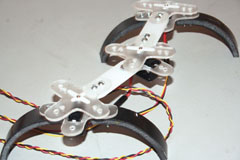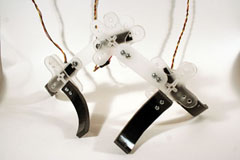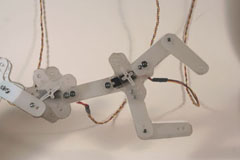| |
Interactive Evolutionary Structure (Spring 2005) |
|
| |
|
|
| |
|
| DESCRIPTION |
It has been a while since bottom-up design methodology became a major research field in system science. In a bottom-up system, complex behavior as a whole, which is more than the sum of the parts, emerges from aggrigation of components. As shown in cell-automata and Boids, those systems are of capital interest because of the qualitative disparity between the simplicity of the system and complex phenomena emmerging from there.
However, it is difficult for a user to interfere with the system's overall behavior because of the essential inability to take an analytical process to predict the behavior and severe parameter coordination to adjust it. Most of the systems, however it is an important step to open up a whole new field, tend to be a subject of an objectless experimentation where a user blindly changes to see and enjoy a result. There is also an issue that it is difficult to be applied to a practical situations which would benefit from positive mutual dependency between unpredictability of the system and controlability of it. Moreover, it is a question that we have to answer how it could be possible to engage in the systems' emergent process in terms of user's active interactivity.
This research incorporates evolutionary approach to allow a bottom-up system to have an elasticity to change itself to fit a user's expectation. In general computerized generative systems, output is generated as a result of calcuation based on given parameters. Those parameters however encapsulated in an interface and abstruction are essentially what a user is allowed to manupulate and interact with. In case of interacting with generative artworks, a user often manipulate parameters through an abstraction layer or an interface, which often engages strong visual and sensorial experiences.
In contrust to this type of generative systems, evolutionary systems can receive user's subjective evaluation of the result and gradually evolves to satisfy the user's demand. This eliminates the need for adjusting the parameters by hand. Parameters behind are manipulated by the system's side in accordance with the user's creteria for evaluation. Now, a user can interactive with the system on the level of global behavior of the system, not by numerical parametrized specification. This is the major reason why evolutionary system is appropriate as a computational model for interaction with emergent systems.
|
| COMPONENTS |
The system has three major kinds of components: Motorized joint, straight bars and curved bars. Those components are designed in such a way as to allow a user to easily put them together and create structures.
Motorized joint |
Straight bars |
Curved bars |
 |
 |
 |
|
| STRUCTURAL DESIGN |
A motorized joint is controlled by a microcontroller (Atmel AVR microcontroller). The microcontroller does all the computation to make the overall structure evolve and each motorized joint is self-packaged including a battery and RF communication capability. GA-based internal process receives a user's evaluation of pheno-type and based on the evaluation, it generates movements fittest to the user's expectation.
|
| SAMPLE STRUCTURES |
One notable apsect of this evolutionary system is that it does not constrains the type of forms that can be evolved. The movement that the joint makes is described in a simple set of parameters - frequency and angle of movement - and as long as a user can evaluate the systems global movements that the system as a whole create, the system can automatically tune the parameters to perform in the way as to satisfy the creteria of user's evaluation.
 |
|
| animal-like structure 1 |
animal-like structure 2 |
| |
 |
| robotic arm |
|
 |
|
|
| EVOLUTIONARY APPROACH - ANALYSIS |
 |
One distincitve point is that this research employs a physical form to solicit a user's evaluation. Usually, in a general evolutionary system, all the individual genes are evaluated at the same time and automatically done by one single evaluation function. However, a physical object can provide only one form at the same time. Therefore it is quite a barden on a user to let him or her evaluate all the individual phenotype. In general Interactive Evolutionary Systems, this user's fatigue is a major problem. Physical implementation makes the process of evaluation expensive in terms of cost in time and a user's mental load. It is also demanded that the global behavior is presented in such a way that a user can easily evaluate it. A user can provide a feedback to the system on at least two levels: positive or negative. The system can provide more than those two choices for evaluation. Recent psychological research has shown that a maximum torelable number of choices for an average user is from 7 to 10. |
However, being physical, this system also has advantages and distinct qualities intrinstic to this physical aspect.
1. user's evaluation changes
Subjectivity of human beings is not consistent all the time. Once seeing the result of change, a user's creteria for evaluation may change. Also, the system accepts evaluation from more than one user. It would be also possible for the system to store preferences of multiple users as evaluation process goes from person to person. It might be possible even to express user's preference later on just like a past process of evolution appears as vestigial organs in animal bodies.
2. embodiment in the physical environment
Evaluation process can be done on an unconscious or natural level. The system can absorb dynamics of the external environment by taking the effect of global behavior of the system on the environment.
|
| REFERENCES |
Takagi, H. (2001). Interactive Evolutionary Computation: Fushion of the Capacities of EC Optimization and Human Evaluation. Proceesings of the IEEE 89, 9, pp. 1275-1296
Nolfi, S and Floreano,D (2000). Evolutionary Robotics -The Biology, Intelligence, and Technology of Self-Organizing Machines
Bentley, P and Corne, D (2001). Creative Evolutionary Systems
Kosorukoff, A (2000). Human Based Genetic Algorithm (http://www.geocities.com/alex+kosorukoff/hbga/hbga.html)
Sims, K (1994). Evolving Virtual Creatures. Proceedings of SIGGRAPH 1994 (http://www.genarts.com/karl/papers/siggraph94.pdf) |
|
|
|